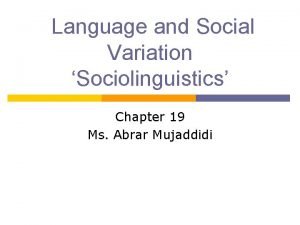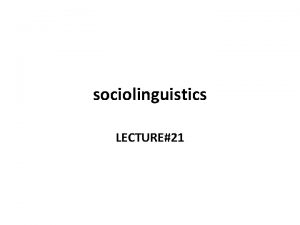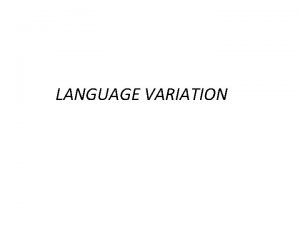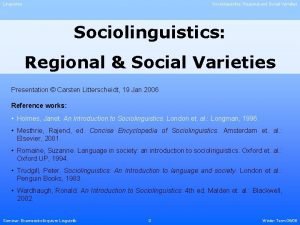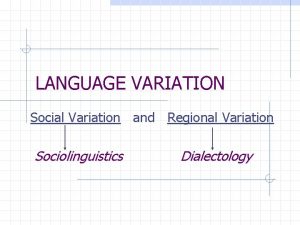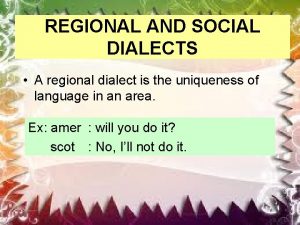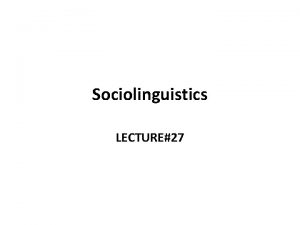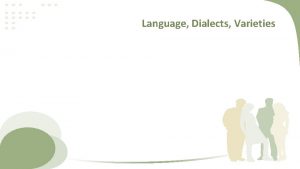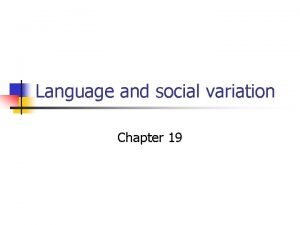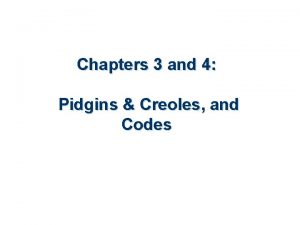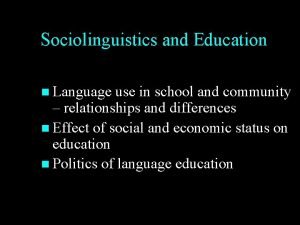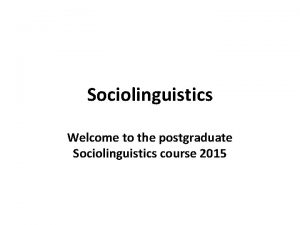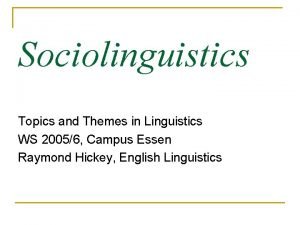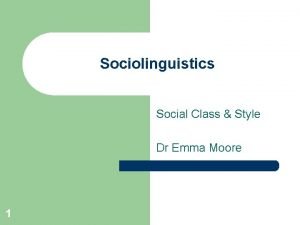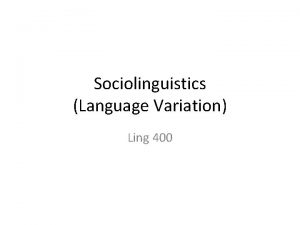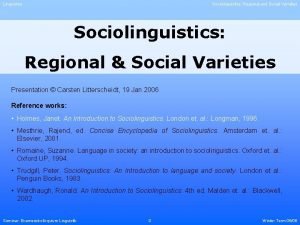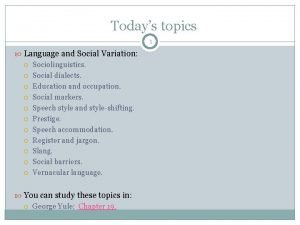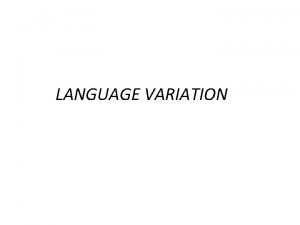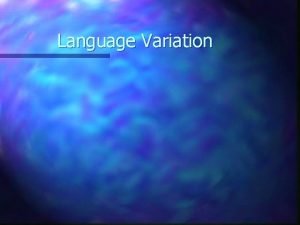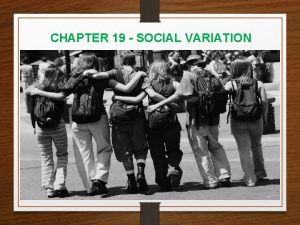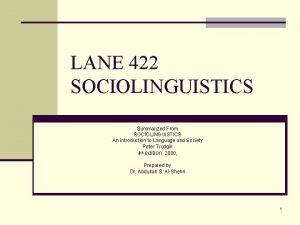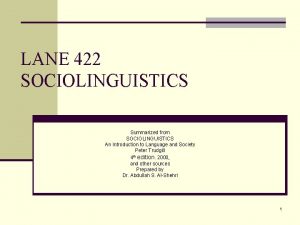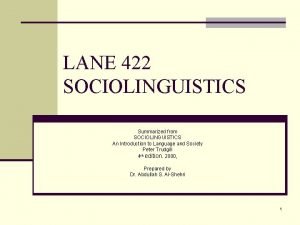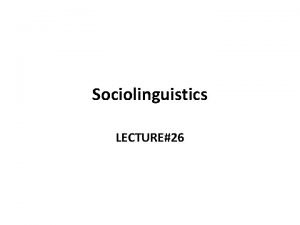Language and Social Variation Sociolinguistics Chapter 19 Ms




















- Slides: 20

Language and Social Variation ‘Sociolinguistics’ Chapter 19 Ms. Abrar Mujaddidi

Introduction p Certain varieties of a language, such as ‘slang’, are more likely to be used by some individuals in the society more than others. p People who live in the same region, but who differ in terms of education and economic status, often speak in quite different ways. p A speech community is a group of people who share a set of norms and expectations regarding the use of language.

Sociolinguistics p Sociolinguistics is used generally for the study of the relationship between language and society.

Social dialects has been mainly concerned with speakers in towns and cities. p In the social study of dialect, it is social class that is mainly used to define groups of speakers: 1. middle class 2. working class p

cont. , p Certain features of language use are treated as relevant in the analysis of social dialects: - pronunciation - words and structures

Education and Occupation Idiolect: The personal dialect or the individual way of speaking of every person. p Although we have different idiolects, we generally tend to sound like others whom we share similar educational and/or educational backgrounds. p E. g. people who didn’t complete college it wasn’t us that done it p

cont. , p Labov (1966) experiment p. g. 207: The pronunciation of postvocalic r in New York city speech.

Social markers A social marker refers to having a feature occur frequently in a person’s speech (or not) marks him/her as a member of a particular social group, whether he/she realizes is or not. p E. g. 1. Final –g dropping in words such as playing and making is a marker of a lower class and less education. 2. the same applies to initial h- dropping in words such as horse and hungry. p

Speech style and style-shifting p Speech style : 1. formal style 2. Informal style p A change from one style to the other by an individual is called style-shifting.

Prestige p Overt prestige: occurs when the style-shift happens in the direction of a form that is more frequent in the speech of those perceived to have higher social status. p Covert prestige: It refers to the ‘hidden’ status of a speech style as having a positive value in groups which do not exhibit style shifts like other groups. - why is that?

Speech accommodation p Speech accommodation is our ability to modify our speech toward or away from the perceived style of the person(s) we are talking to. p Convergence: is when we adopt a speech style to reduce social distance. p Divergence: is when a speech style is used to emphasize social distance between speakers. p Refer to p. g. 210 for examples.

Register and jargon p A register: is a conventional way of using language that is appropriate in a specific context, which may be identified as situational, occupational, or topical. p Examples of register: 1. religious register. 2. legal register 3. linguistic register.

cont. , p One of the features of registers is the use of jargon, which is a special technical vocabulary associated with a specific area of work or interest.

Slang p Slang is typically used among those who are outside established higher groups. p Slang or ‘colloquial speech’ describes words or phrases that are used instead of more everyday terms among younger speakers and other groups with special interests. p E. g. bucks awesome Benjamins

cont. , p Taboo terms are words which people avoid for reasons related to religion, politeness, and prohibited behavior.

Social barriers p Social barriers, such as segregation and discrimination, serve to create marked differences between social dialects. p E. g. the case of AAVE

Vernacular Language p Vernacular is a general expression for a kind of social dialect, typically spoken by a lower-status group, which is treated as ‘non-standard’ because of marked differences from a socially prestigious variety treated as the standard language. p E. g. AAVE Chicano English Latino English

cont. , p The sounds of the vernacular (AAVE): E. g. - reduction of final consonant clusters (lef han) instead of (left hand). - Initial dental consonants often pronounces as alveolar stops (think that) pronounced as (tink dat)

cont. , p The grammar of a vernacular: E. g. - double negatives (he don’t know nothing). - Absence of forms of verb ‘to be’.

Thank you!!
 Social variation of language
Social variation of language Sociolinguistic variation
Sociolinguistic variation Regional variation in language examples
Regional variation in language examples Regional variation in sociolinguistics
Regional variation in sociolinguistics Language variation
Language variation Examples of social dialect
Examples of social dialect Bell's seven criteria for language
Bell's seven criteria for language Language dialect and varieties in sociolinguistics
Language dialect and varieties in sociolinguistics What is direct variation
What is direct variation Direct and inverse graphs
Direct and inverse graphs Coefficient of determination formula in regression
Coefficient of determination formula in regression Register (sociolinguistics)
Register (sociolinguistics) Standard language slideshare
Standard language slideshare What is pidgin
What is pidgin Sociolinguistics and education
Sociolinguistics and education Language variation definition
Language variation definition Variationist sociolinguistics
Variationist sociolinguistics Sociolinguistics topics for presentation
Sociolinguistics topics for presentation Define overt prestige
Define overt prestige Sociolinguistic
Sociolinguistic What is sociolinguistics
What is sociolinguistics
